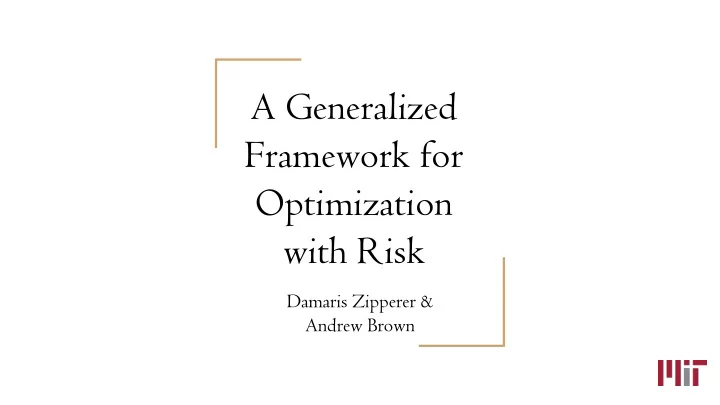

A Generalized Framework for Optimization with Risk Damaris Zipperer & Andrew Brown
Agenda Problem Overview of Results Methodology Review Further Applications Wrap-Up
Background Problem • Long term forecasts • Underlying risk • Trying to optimize in volatile environments
Building a Schedule So, which problem do we fix: cost or coverage? Task 3 Task 8 Task 5 Task 7 Task 2 Task 1 Task 4 Task 6 Task 9
Cost vs. Coverage Cost ($): Labor Cost (Including Extra Costs Due to Forecast Inaccuracy) Coverage (%): The chosen solution’s performance against the actualized schedule
Current Schedule Optimization isn’t… Optimal
Results Overview Deterministic Optimization Solution: ~62% Coverage, $770,000 Cost Risk-Integrated Optimization Solution Range of Cost/Coverage Options At Equivalent Cost ($770,000), 84% Coverage
Creating a Deterministic Solution Duration Description Total Cost ($) Unit Cost/day ($) Block of Hours One worker for one full day 81 81.00 6 Month One worker for 130 Work days 8668 66.68 7 Month One worker for 152 Work days 9574 62.99 8 Month One worker for 174 Work days 10942 62.89 9 Month One worker for 195 Work days 12309 63.12 10 Month One worker for 217 Work days 13677 63.03 11 Month One worker for 239 Work days 15045 62.95 12 Month One worker for 260 Work days 15858 60.99
Creating a Deterministic Solution Cumulat Cu ative Hires matrix: Object ctive Funct ction: 𝑧 #,% * & ! ! 𝑦 #,% 𝑑 % ; Co Constrai aints: %'( #'( where m = total contract types and n = total schedule days 𝑦 #,% ≥ 0 Co Costs for each contract type ( j ) are denoted as: 𝑧 #,% ≥ 0 𝑑 % Deci cision var ariab ables of the model, x, planned hires, by * day ( i ) and contract type ( j ) ∶ ! 𝑧 #,% ≥ ℎ𝑓𝑏𝑒𝑑𝑝𝑣𝑜𝑢 𝑠𝑓𝑟𝑣𝑗𝑠𝑓𝑛𝑓𝑜𝑢 𝑏𝑢 𝑒𝑏𝑧 𝑗 𝑦 #,% %'(
Defining How and Why Schedules Change Risk Par aram ameterizat ation • Which task types move • What is the probability that they move • Which direction do they move • Are there interdependencies • Are there tensions that must be preserved Using Historic c Dat ata
Simulation Tasks Simulate Optimize Assign risk 1.Import different each coverage and analyze schedules schedule values 1.Understan Weigh the Assign new Output d the risk coverage requirement portfolio of resulting impact s options statistics
Using Risk to Simulate Schedule Iterations Our simulator takes in risk parameters, an input schedule, and iterates…
�� Risk Coverage Assessment 95th Percentile Set Coverage, Sample Schedule 40 35 The risk coverage for each simulated schedule was 30 Headcount 25 20 then calculated as follows: 15 10 5 LNOPQRSPT ∑ GHI#J#H&JK L,M 0 𝑆𝑗𝑡𝑙𝐷𝑝𝑤 B = 1 − LNU 1 29 57 85 113 141 169 197 225 253 281 309 337 365 393 421 449 477 505 533 561 589 617 645 673 701 729 757 785 813 841 869 897 925 953 981 1009 1037 1065 1093 1121 1149 ∑ VWXYZ L Schedule Day
Risk Statistics
Bottom-Up Risk Integration GH`#aHbZcdHaWeHfgW`HZcd 𝑸𝒔𝒑𝒄 = ; (hh%fgW`HZcd where BaseCov = coverage achieved by input schedule. 𝑶𝒇𝒙𝑰𝑫𝑺𝒇𝒓 𝒋 = 𝑨 ∗ 𝐵𝑤𝐸𝑓𝑔𝑇𝑢𝐸𝑓𝑤 # + 𝐵𝑤𝐸𝑓𝑔𝐵𝑤 # + 𝐶𝑏𝑡𝑓𝑇𝑑ℎ𝑓𝑒 #
Top-Down Risk Integration 𝐻𝑏𝑞 𝑄𝑓𝑠𝑑𝑓𝑜𝑢𝑏𝑓 = (𝑧 − 𝑦 ) 𝑧 ⁄ This gap percentage was used to determine the percentile value to utilize across list of daily average deficiencies
Results
Cost-Coverage Frontier Co Cost Co Coverag age F Frontier – Me Method 1 1 Cost-Co Co Coverag age F Frontier – Me Method 2 2 1,000,000 790,000 785,000 950,000 780,000 900,000 Base Optimization 775,000 Solution Cost Cost 850,000 770,000 Co Co Base Optimization 765,000 800,000 Solution 760,000 750,000 755,000 700,000 750,000 55% 65% 75% 85% 95% 55% 60% 65% 70% 75% 80% 85% 90% Co Coverag age Schedule Co Coverag age
Coverage Assessment & Prediction Simulat ated v vs. Act Actual al Co Coverag age – Me Method Simulat ated v vs. Act Actual al Co Coverag age – 1 Me Method 2 2 100% 100% 80% 80% Coverage Coverage 60% 60% 40% 40% 20% 20% 0% 0% 0 5 10 15 20 0 5 10 15 20 Schedule Iteration Schedule iteration Actual Coverage Predicted Coverage Actual Coverage Simulated Coverage
Generalized Framework Measure Risk Parameters Simulate Scenarios with Risk Parameters Optimize Individual Scenarios Measure Base Set Coverage and Deficiency Statistics Develop Strategically Appropriate Method Develop New Requirements, Optimize Remove Coverage Not Exploiting Profit Gains Re-determine Coverage, Benchmark Costs
Further Applications • Genetic Algorithms approach • Applications for other S.C. functions • Other Industries • Method for situations without prior history
Any Questions?
Recommend
More recommend